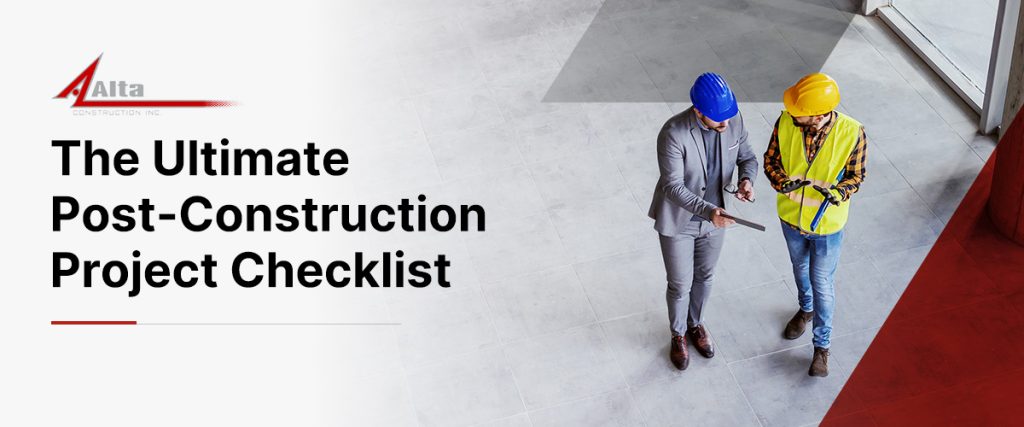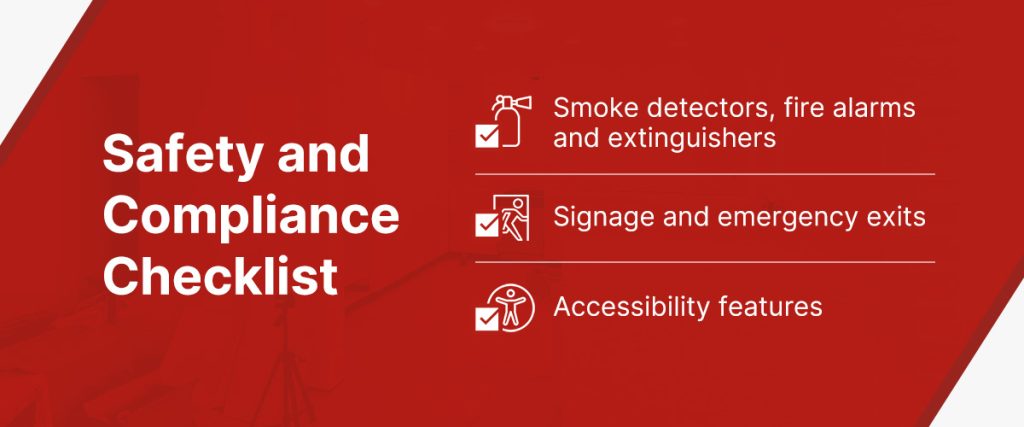
Post-construction is the period right after a construction project is completed when the crews leave and the work is complete. If your building has just finished renovations, you probably have a hundred different things on your mind. Having a post-construction checklist keeps you organized so you can take the necessary next steps. This ensures project completion and quality assurance for you and any potential tenants.
The following are essential items to keep on your commercial post-construction checklist.
1. Primary Post-Construction Inspection Checklist
As soon as the construction job is complete, you’ll want to walk through the site with your general contractor or project manager to verify all the work was completed to the specifications agreed upon in your contract. Your checklist for the new construction walk-through should include questions such as:
- Have all work tools and equipment been removed?
- Are all appliances installed and operational?
- Have all utilities been reconnected?
- Did the construction work cause any damage to the existing property?
Performing this primary post-construction inspection can ensure you catch issues as soon as possible, allowing the contractor to address them quickly.
You will also need to hire a qualified construction inspector to perform a thorough review of the property. They have the knowledge and experience to verify the work conforms to all necessary building codes and zoning regulations and will assess the building’s structural integrity and safety. The inspector will also investigate all heating, ventilation and air conditioning (HVAC), plumbing and electrical components.
2. Compile Project Documentation
Throughout the construction process, ensure you or a member of your team is collecting all relevant documentation, such as contracts, quotes, receipts and communications. File these documents away so you can reference them in the future. You might need them to provide proof of payment, resolve contract disputes or file for tax deductions. To more easily keep track of everything, you can use software that provides a central database in the cloud for your documentation.
After the project is done, gather any warranties, manuals and maintenance guides for equipment that was installed — pay close attention to equipment that requires operator training or regular maintenance. Make sure you have copies of this equipment documentation for any tenants who will be using it.
3. Systems and Utilities Checklist
Your systems and utilities checklist will include three key sections — electrical, plumbing and HVAC. While your construction inspector will perform a thorough check of all these elements to ensure they comply with relevant codes and safety regulations, you will need to verify these systems comply with the project specifications:
Electrical
Complete the following checklist items to verify your electrical systems are functioning:
- Test all outlets and switches
- Check all lighting fixtures for missing or inoperable bulbs
- Review circuit breakers and panel functionality
- Verify all breakers are labeled to the correct circuit
- Ensure areas with potential water exposure have ground fault circuit interrupter (GFCI) outlets
Plumbing
Inspect plumbing systems for the following:
- Inspect pipes for leaks
- Check water pressure
- Look for signs of water damage, mildew or mold
- Check thermostat settings on any hot water heaters
HVAC
Evaluate heating and cooling systems for efficiency by:
- Testing that both the heating heats and cooling cools properly
- Checking all vents and ducts operate and are not obstructed
4. Safety and Compliance Checklist

It’s also important to check elements related to safety and compliance that may have been updated or altered during construction. These include:
- Smoke detectors, fire alarms and extinguishers: Ensure you still have the proper number and type of smoke detectors, extinguishers and fire alarms, and that the system is operational. Check your state fire regulations and codes and standards from organizations like the National Fire Protection Association (NFPA) for other fire safety considerations.
- Signage and emergency exits: Verify that all directional signage and emergency exit features are present and visible according to the applicable regulations in your locality. Make sure all exit routes are clear.
- Accessibility features: Check the compliance and construction of accessibility features like railings, ramps and elevators. For specific building guidance, consult the standards set forth by the Americans with Disabilities Act (ADA).
5. Post-Construction Cleaning Checklist
The contractor will handle most clean up after construction, but you should also plan to invest some time into cleaning. This ensures your property is spotless, and cleaning will also give you a closer view of things you might have missed in your primary inspection.
Interior Cleaning
Post-construction cleanup for the inside areas will primarily deal with dust and debris removal. Start by manually removing larger pieces of debris and unneeded construction materials, and then use a shop vac to vacuum up smaller debris and dust. Don’t forget tight or hidden areas like corners, under appliances and windowsills. Use a microfiber cloth to wipe down surfaces and windows.
Floor cleaning is also important — consider buying or renting a commercial floor scrubber to clean large spaces more efficiently. Just ensure the cleaning solution you use is compatible with the flooring material in your space.
Exterior Cleaning
Exterior commercial construction cleanup usually focuses on debris removal. Check that any remaining dumpsters will be picked up and ensure all old furniture and appliances, scrap metal and any hazardous materials are properly sorted and dealt with. Clear and sweep exterior walkways and surfaces — you can use a pressure washer to clear stubborn mud and organic materials, while special cleaning agents may be required to clean things like old paint or rust.
6. Final Post-Construction Inspection
Once everything is clean, you can examine the small details more closely. Inspect all seals, windows and doors to ensure they’re properly fitted and there are no cracks or gaps. Check for imperfections in flooring or paint, and take another look at any installed cabinetry and appliances. This final inspection allows you to identify any final issues that may need to be addressed by the contractor.
If you performed the renovations for a tenant, offer them a chance to do a walk through to review all the updates. If you’re putting the place on the market, consider having professional photos to post with the listing. Even better, you can take advantage of technology to showcase your building layout virtually with interactive 3D space applications.
Choose Alta Construction for Your Next Project
Alta Construction is a full-service construction firm, meaning we provide support from project inception to completion. Our team can take your ideas and create detailed designs and schematics to suit your needs. As licensed general contractors, we can partner with you to manage all phases of the project to ensure everything is done right and on schedule. View examples of completed projects in our gallery.
Leveraging advanced technologies, we offer superior service and communication, enhancing transparency throughout the entire construction process. Talk to a member of our team today.


